At St. Mary Church, Norwalk, CT:
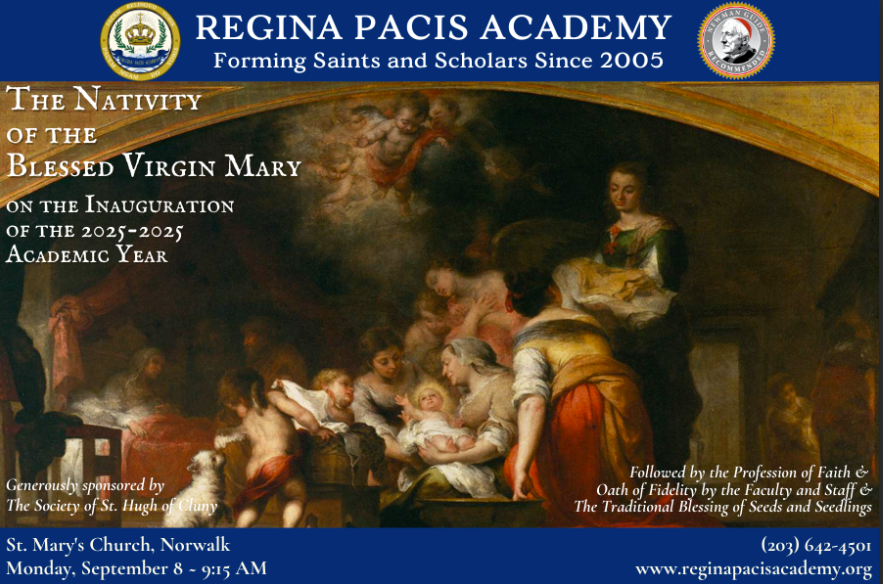
At St. John the Evangelist Basilica in Stamford:
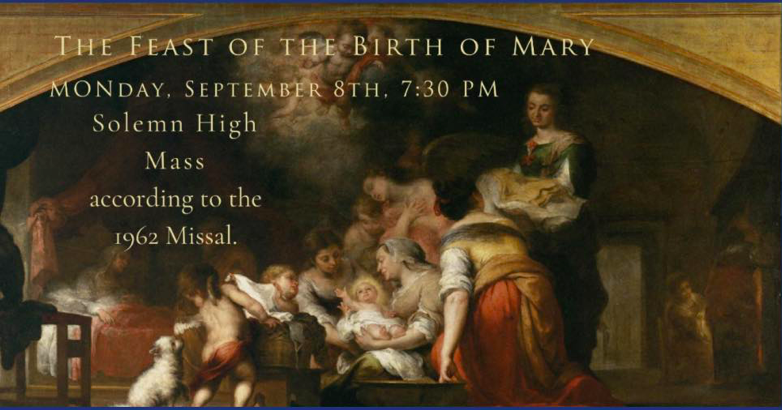
4 Sep
2025
2 Sep
2025
Matthew Walther writes in The Wall Strreet Journal on the persistence of the Latin Mass and on a distresssing aspect of Catholic culture:
The best sermon I’ve ever heard was delivered by Father James Richardson in Kalamazoo, Mich., in 2018. It was the Sunday after news broke about the proclivities of the late Cardinal Theodore McCarrick. “I’m sick of the lying,” Father Richard began. For the next 10 minutes, he repeated “I’m sick of,” anaphora-like, with each instance followed by another scandal….
I still feel that way. Lies are the air Catholics have breathed for decades, which is why it was startling to witness a priest simply stop inhaling.
The stench of untruth, it seems is still with us.
(Mr. Walther goes on to discuss the revelations about the survey which allegedly supported Traditionis Custodes and the Vatican’s reaction to the disclosure.)
Walther, Matthew, “The Latin Mass Lives on,” at A13 The Wall Street Journal (8/29/2025)
Now I made the same point some years ago:
“But out of this seemingly inevitable tragedy (the likely collapse of the institutional Church as a result of the Francis papacy) may come at least one advantage: the truth. For far too long the Catholic Church has continued to take refuge in fantasies of stability and success, of secular standing and influence. You need look only at any of the official Catholic media to confirm this – isn’t the Al Smith Dinner in New York the incarnation of this self-deception? Even the supposedly hard-nosed liturgical traditionalists remained to some extent in thrall to these mirages. The poison of dishonesty has eroded the faith more surely than any persecution or loss of worldly advantages could do.
Let be be finale of seem! Jettisoning the Catholic culture of pretend is the first, most necessary step towards reform.” (“Let be be Finale of Seem,” The Society of Saint Hugh of Cluny ( 11/11/2017)
More recently, Ed Condon has asked: “Can Pope Leo resist the Vatican Culture of ‘Alternative Facts’?” (The Pillar, 8/19/2025)
Even from the outside looking in, it seems clear that, at least at some level, the Vatican’s official response to evidence of potential wrongdoing is to deny either the evidence or the wrongdoing could exist.
(Regarding the Vatican’s aggressive response to the disclosure of a letter by the late Cardinal Pell and a critical report on Vatican financial practices) In so doing, the press office appeared to prefer a version of events in which Pell’s letter and Milone’s report simply never existed, rather than engage with what either document said.
While there is no means for journalists to compel any different approach from a press office, the problems which would arise if the same “alternative facts” were imposed upon the pope by his officials are obvious.
As Matthew Walther says, the Catholic culture of deceit is alive and well. It remains to be seen whether and how Pope Leo will start to confront it.
30 Aug
2025
We welcome this history of the Viri Galilaei written by member Steven Merola:
On September 9, 2015, a group of men under the direction of David Hughes met in the basement chapel of St. Mary’s parish in Norwalk to begin to learn to chant the office of Vespers. They toyed with several ideas for a group name, including the incipit of Psalm 132, Ecce quam bonum (Lo how good and pleasant it is, for brothers to dwell in unity). Ultimately, they settled on the name Viri Galilæi, Men of Galilee, the incipit of both the first vespers antiphon and the introit of the Ascension. This name, connected both to the traditional Office and Mass, would prove fitting: after a year of practicing Vespers, the Viri began to sing the propers and ordinary of the Wednesday night Mass at St. Mary’s.
Throughout the past decade, Viri Galilæi has met continuously on Wednesday evenings to chant a Missa Cantata and the office of Vespers. The group has also studied medieval polyphony like Machaut’s Messe de Nostre Dame and the chants of the Codex Calixtinus. After an initial four years at St. Mary’s, the Viri has traveled all over the Diocese of Bridgeport and brought sung Mass and Vespers to no less than six different parishes and visited many more. The group has provided music for weddings, Requiems, first Masses, Tenebrae, and other occasional liturgies throughout the tristate area. At present, Viri regularly sing for a Wednesday Missa Cantata and Vespers at the Oratory of the Sacred Heart in Georgetown, CT.
In honor of their tenth anniversary, the Viri Galilæi will be chanting Solemn Vespers at St. Cecilia Church in Stamford, CT on the day of their founding, Tuesday, September 9th, 2025 at 7:00 PM. Fr. Richard Cipolla will officiate. All friends of the Viri are most warmly invited to attend to celebrate this milestone.
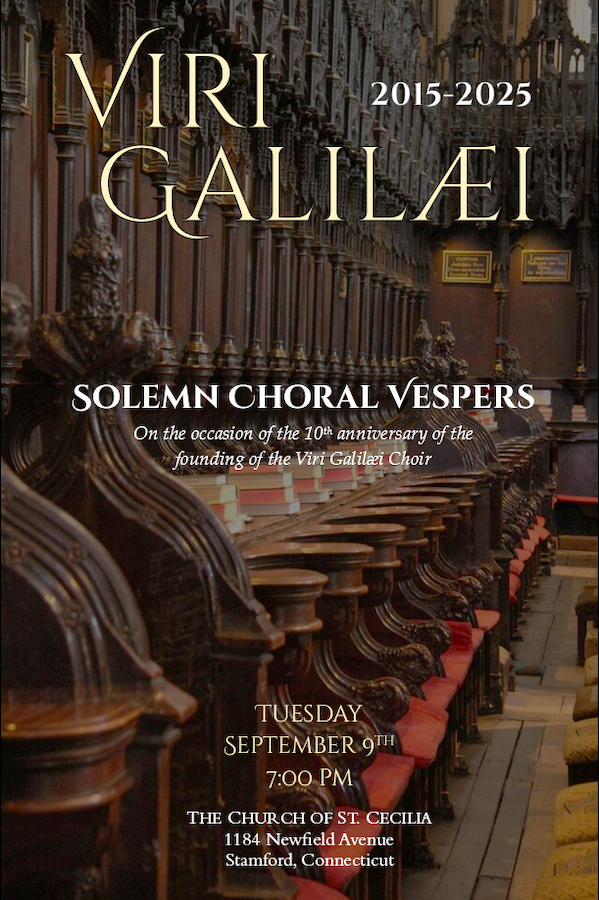
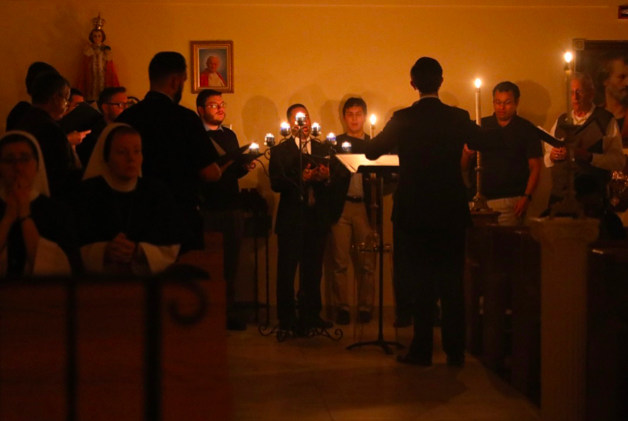
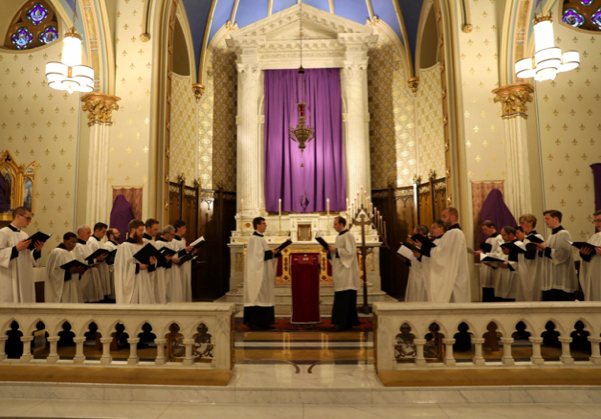
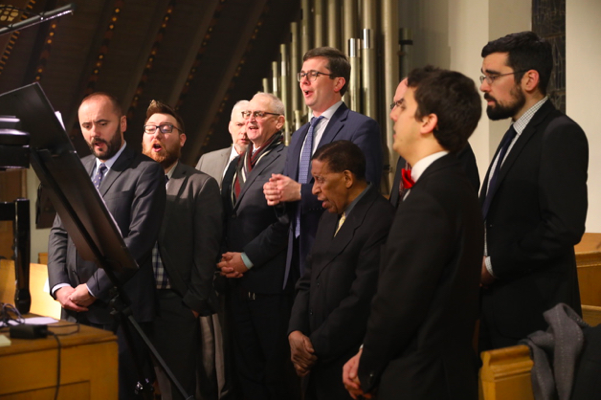
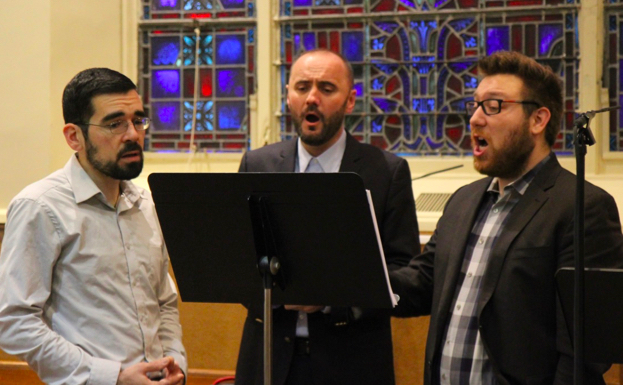
23 Aug
2025
18 Aug
2025
THe Bridgeport diocese now has an “Apologetics Director.”
Brennan, Rose, “Suan Sonna named new Apologetics Director,” 3 Fairfield County Catholic(July/August 2025).
In his new position, Mr. Sonna proposes to invite speakers, to organize retreats, “conversations,” parish “Apologetic Sundays,” “testimony nights,” etc.
“Apologetics Begins,” bridgeportdiocese.org (August 6, 2025)
In Brennan’s article, supra, we learn that :
“(Sonna’s) favorite topics to speak on include sacred Scripture, moral theology and the papacy. Notably, his article “Lessons from St Peter’s Papacy” will appear in the upcoming book Faith in Crisis: Critical Dialogues in Catholic Traditionalism, Magisterial Authority and Reform.”
But what kind of book is Faith in Crisis (Andrew Likoudis, ed., En Route Books and Media, St Louis MO)?
Judging from the extensive blurbs in the advance notice, it will be first and foremost an anti-traditionalist polemic. Then, it will defend the papacy as it was exercised under Pope Francis. The overall objective will undoubtedly be to vindicate the clerical establishment.
The editor is Andrew Likoudis:
Andrew Likoudis is a Catholic scholar and entrepreneur with degrees in Communication from Towson University and Business Administration from the Community College of Baltimore County. He has served as a fellow at Johns Hopkins University and at Goldman Sachs’ 10,000 Small Businesses initiative. His professional experience includes a role as a business development administrative assistant at theCathedral of Mary Our Queen. Additionally, he has nearly a decade of experience providing hospitality hosting with Airbnb.
Some well-known contributors are drawn from the blogging/podcast world (Mike Lewis, of course); most of the others (like Mr. Sunna) are in the employ of the Roman Catholic Church. But a couple stand out. Rocco Buttiglione, who writes the foreword, is a “conservative” – centrist Italian academic and politician. The last I heard of him, Buttiglione was aggressively defending Pope Francis and specifically Amoris Laetitia. The only real surprise is Cardinal Sarah. Will his contribution discuss his involvement with the traditionalist Chartres pilgrimage? Or his experiences dealing with both a Pope and a Pope Emeritus at the time of the “Amazonian” synod?
The entire project of this book is very establishment (or would-be establishment): confrontational anti-traditionalism, blind ultramontane devotion to the papacy combined with very attenuated “conservative Catholic” notions and charismatic nuances. Now Faith in Crisis has not yet been published. I wonder: are the publisher and perhaps certain contributors waiting to see what direction Pope Leo takes before launching a new assault in the intra-Catholic culture wars? Moreover, the ideological alliance of the contributors in this book is inherently unstable. Consider that En Route Books and Media (the publisher of Faith in Crisis) still prominently features in its catalogue works by Detroit seminary professor Eduardo Echeverria – who was recently summarily sacked by the arch-Bergoglian Archbishop of Detroit.
It seems to me that the present task of Catholic apologetics is to facilitate the recovery of a faith that has been eclipsed – not just among the laity, but also among the clergy and church bureaucracy. Defending the papacy and the institutional Church no longer primarily means, as it did in the 19th century, repelling attacks by outside enemies. Rather, under Francis, these controversial themes primarily served a role in the intra-Catholic cultural wars waged by a once unthinkable alliance of an ecclesiastical bureaucratic establishment and the progressive ( “modernist”) forces. These conflicts have only accelerated the decline of the faith. A valid apologetics would not focus on Church politics and internal enemies but on rekindling the faith. But is that possible? Do we dare admit that we cannot transmit our beliefs when our own faith has become nebulous and uncertain? You cannot give to others what you do not have yourself!
12 Aug
2025
We are pleased to promote these three major multiple-day Traditional Mass pilgrimages in North America. For those with the time and energy, there’s the possibility of attending all three.
August 30-September 1
The 22nd annual Marie Reine du Canada pilgrimage from Lanoraie, Quebec to the miraculous shrine of Notre Dame du Cap will take place on August 30 – September 1 this year, a 100 km (62 mile) walk along the St. Lawrence River in the footsteps of the North American Martyrs. Pilgrims from Ontario, Quebec and the United States are served en route by priests of the Fraternity of Saint Peter, as well as diocesan priests; Mass is celebrated daily in the traditional Roman Rite.
Marie Reine du Canada is a lay-led organization of the FSSP’s apostolate in Ottawa, St. Clement Parish. For registration forms, see: https://www.mariereine.ca/participate. Inquiries can be directed to mariereineducanada@gmail.com.
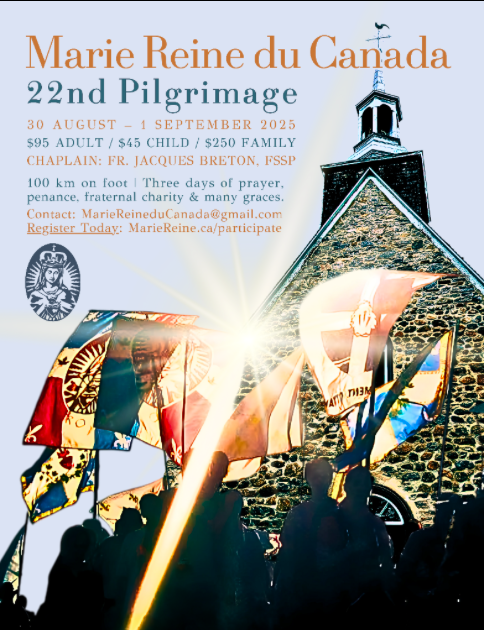
September 26-28
The pilgrimage, now in its 30th year, is a journey of the faithful to Our Lady’s Shrine of the Martyrs in upstate New York, at Auriesville. Here, Jesuit Father Isaac Jogues and Companions were martyred, beginning with lay-brother René Goupîl and several Native American Converts in 1642, and later layman John de LaLande and Jogues himself in 1646.
Since 1996, pilgrims walk near and along the paths the saints followed as captives of the Iroquois. Their journey was hundreds of miles over 28 days under torture. Our journey, modeled on the ancient annual Pentecost Pilgrimage to Notre-Dame de Chartres, France, is 62 miles over 3 days and, though penitential, is full of joy. The purpose is to honor Christ Our King publicly, to pray for the restoration of His Reign in the family and civil society, and to make reparation for sins committed against the Immaculate Heart of Mary.
n.b. There is also an opportunity of you or your loved ones to receive the sacrament of Confirmation in the traditional rite at this pilgrimage. Click here for more details
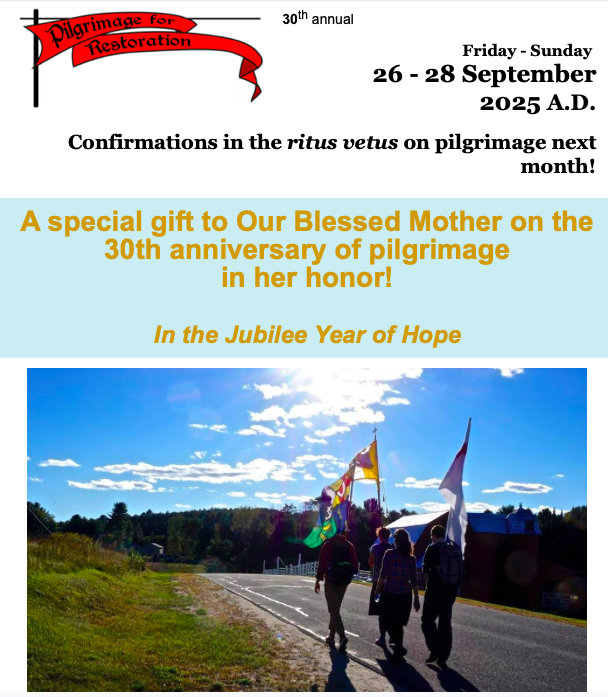
October 9-11
Each October the Three Hearts Pilgrimage guides thousands of participants through a rigorous terrain to the Benedictine monastery at Clear Creek Abbey, located in Northeast Oklahoma.
Last year approximately 3000 pilgrims from 42 states and 11 countries came to pray and sacrifice together in defense of the sanctity of life and in support of the traditional family unit, while pursuing what is Good, True, and Beautiful.
For more information and to register: link
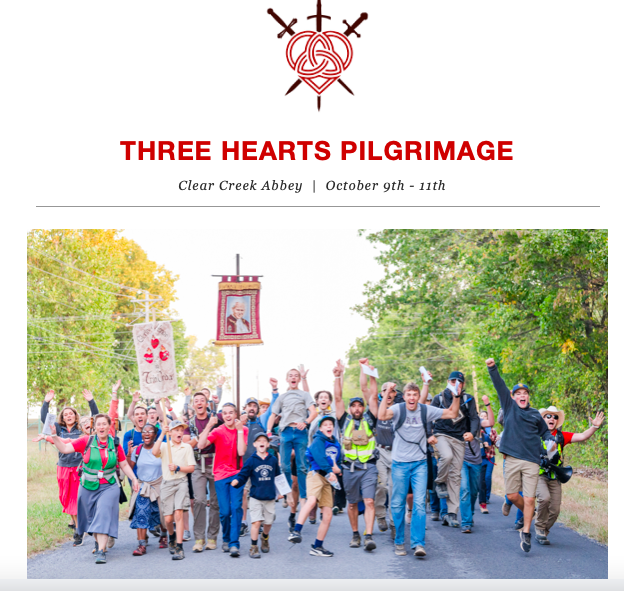
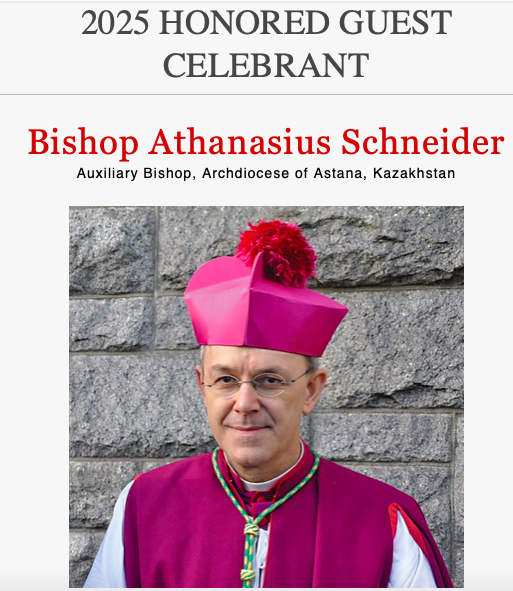
Saturday October 11
This is a one-day pilgrimage to pray for the restoration of the Traditional Latin Mass to its former liberty, a procession between the Catholic cathedrals of Arlington, VA, and Washington, DC.
Full details at https://tlmpilgrimage.com

12 Aug
2025
12 Aug
2025
23 Jul
2025
Messainlatino, that is.
One wonders about the background to this attempted cancellation. It came exactly as the blog was publishing more revelations about the story behind Traditionis Custodes. However it originated, the cancellation generated a thousand times more international publicity than this blog ever could have hoped for.



